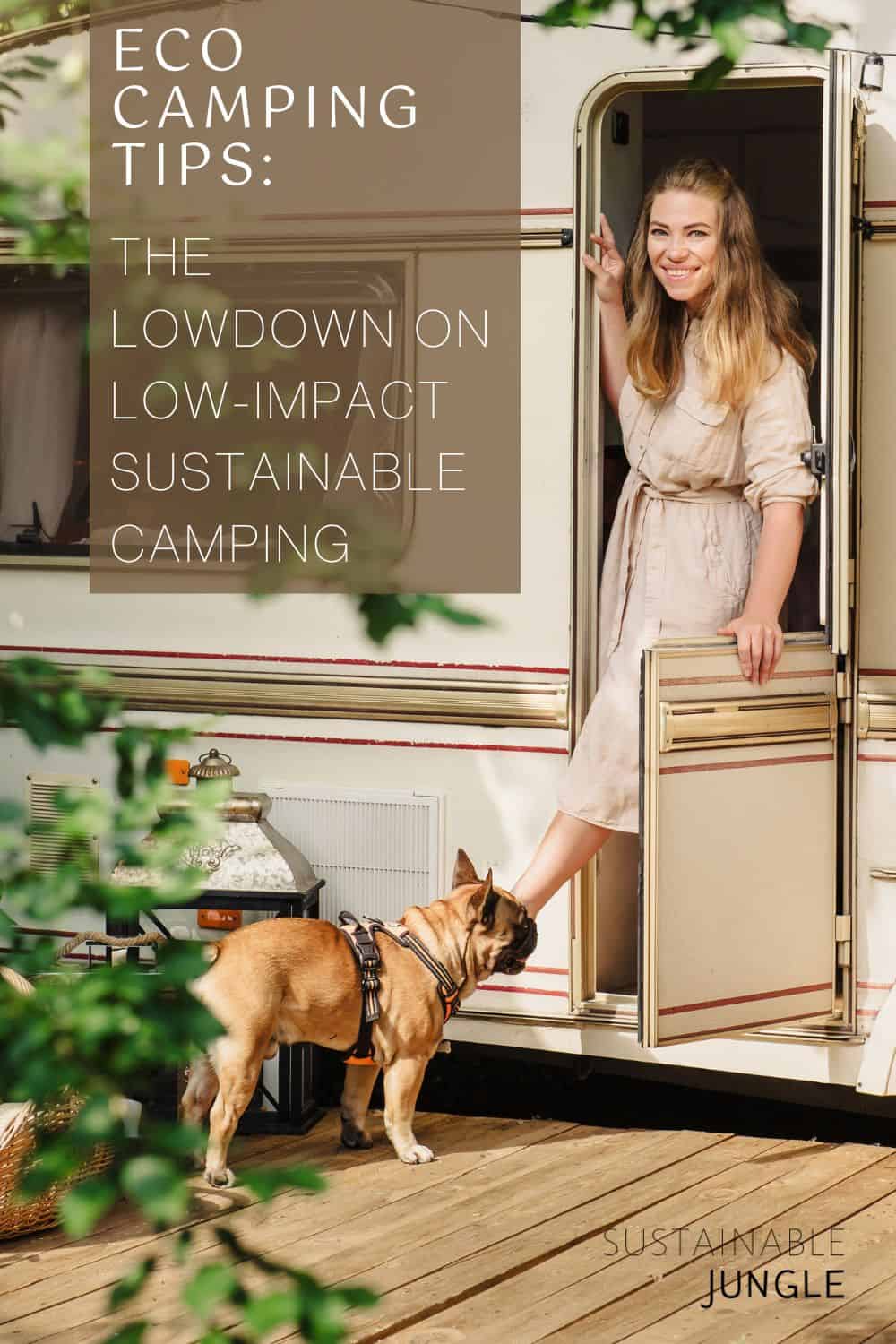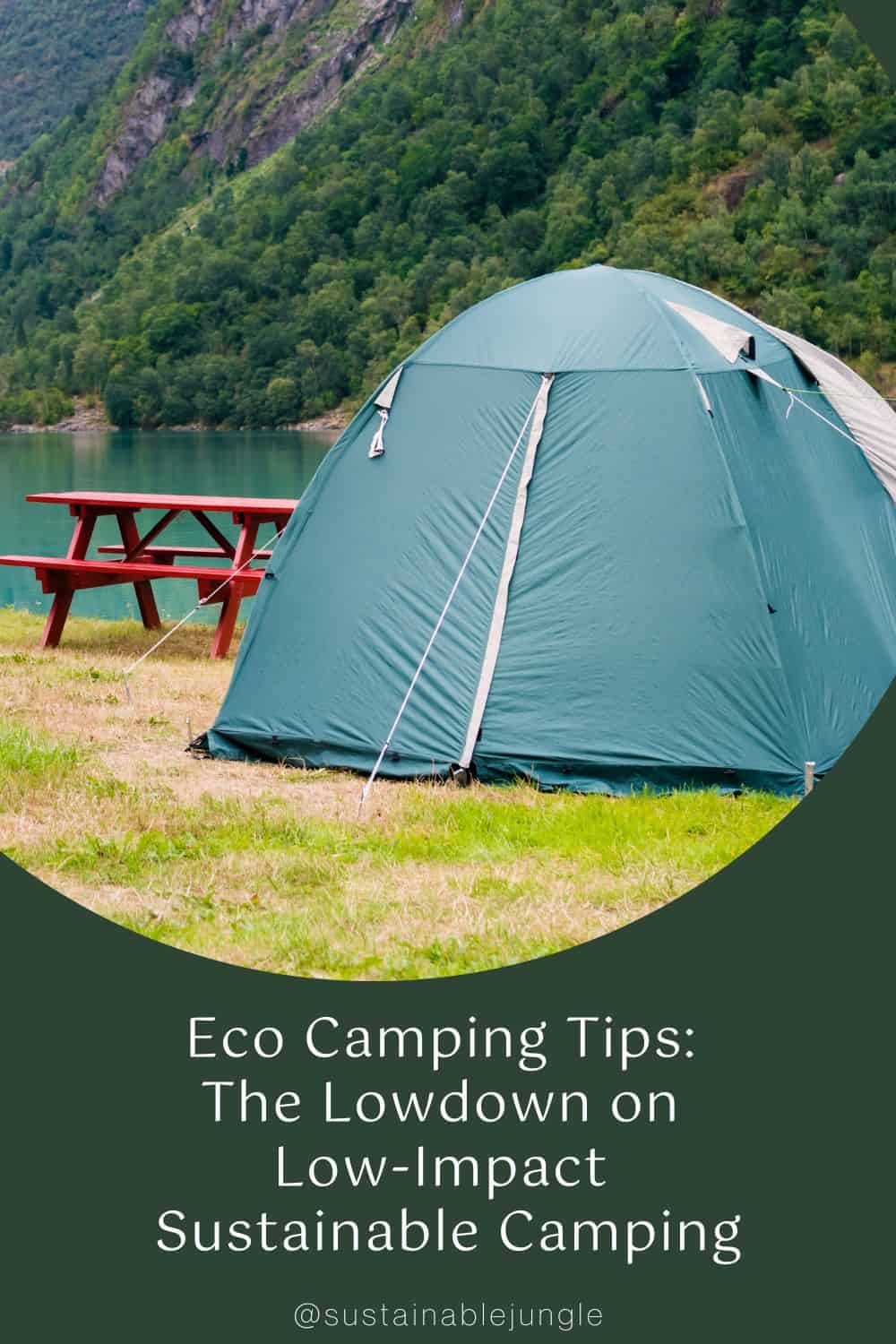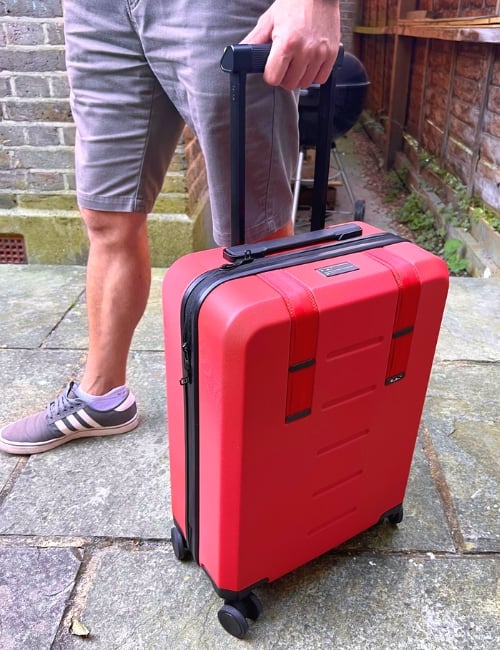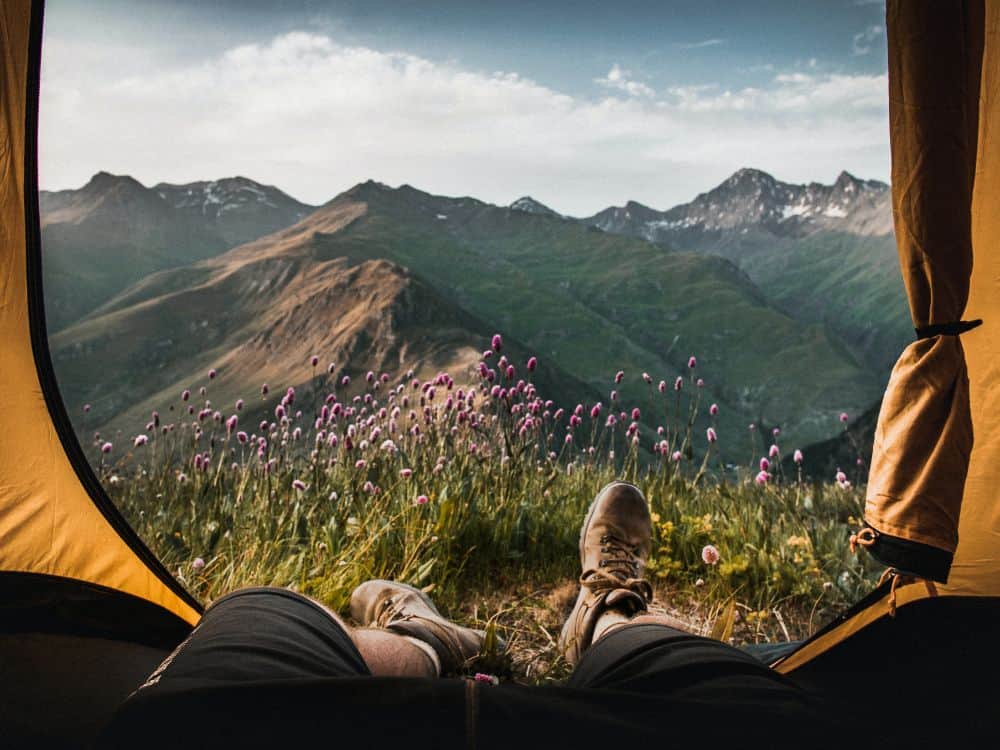
Eco Camping Tips: The Lowdown on Low-Impact Sustainable Camping
Eco camping ensures you leave nothing but footprints and take nothing but memories—except mosquito bites, lots of mosquito bites.
When stepping into Mother Nature’s backyard—especially with rapidly increasing outdoor participation trends—respecting the environment and practicing responsible camping techniques is crucial.
With the correct ethical topo map to guide you and a little planning, you can reduce environmental damage, soil erosion, water pollution, and harm to natural habitats and wildlife.
But where do you start learning eco camping tips?
Right here!
This guide won’t help you figure out how to set up that eco-friendly tent or get your sleeping bag back in its stuff sack, but it will help you eco camp like a (semi) pro and minimize your environmental impact.
The Full List Of Sustainable Camping Tips
- What is eco camping?
- What is Leave No Trace?
- Types of eco-friendly camping
- Choosing an eco camping site
- Travel to your sustainable campsite
- Setting up an eco camp
- Building a sustainable campfire
- Waste disposal on an eco camping trip
- Staying clean and green
- Greener camping gear
- Eco camping tips for after your trip
1. What Is Eco Camping?
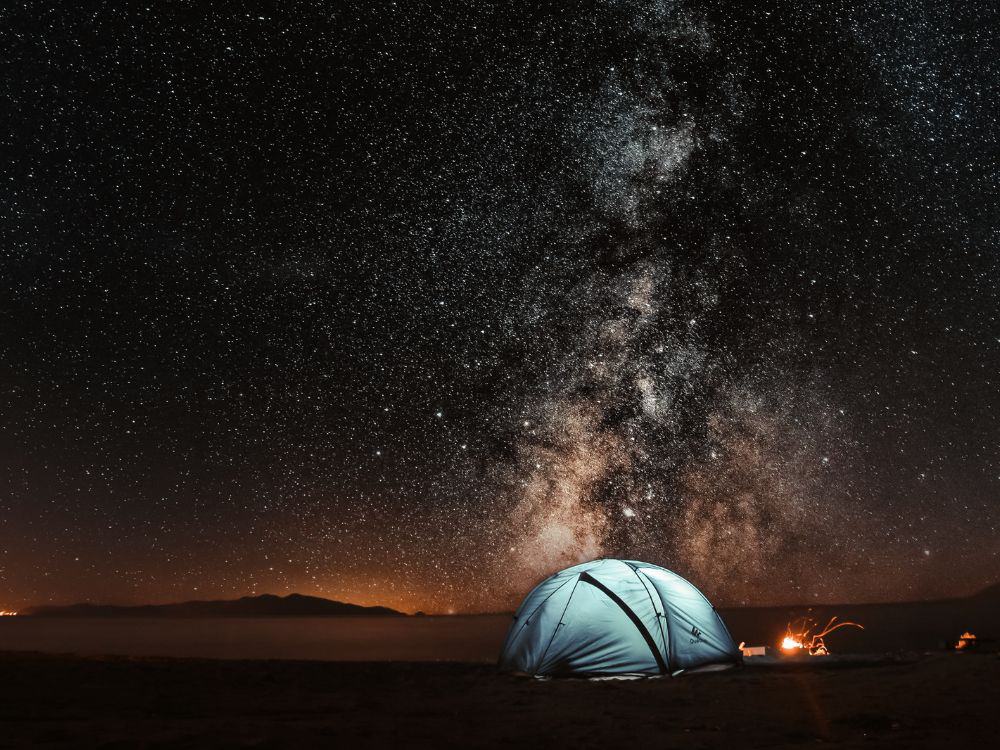
Eco camping, sustainable camping, or green camping, the foundations remain the same—it’s camping in a way that minimizes negative impacts on the environment while enjoying the great outdoors.
Making camping eco-friendly entails (or en-trails) many different concerns, from the gear you pack in your sustainable backpack weeks beforehand to the way you handle trash when exhausted on the hike out.
It’s a practice built on the idea of preserving the beauty of nature, not only for ourselves, but for those who come after us—whether that be next week or next generation.
Unlike in everyday low waste living, where progress trumps perfection, the consequences for straying off the sustainable straight and narrow in nature can be quite large.
For example, it might not seem like a big idea stepping off-trail once or twice, but if you inadvertently step on some fragile cryptobiotic crust, that living organism won’t regenerate for 5-7 years in the best care scenario.
We don’t mean to cast a rain cloud over your trip, especially since Mother Nature is likely to do that already (so don’t forget your sustainable rain jacket!).
We only say this to emphasize the importance of taking these eco camping tips seriously and brushing up on your nature knowledge before bushwhacking through the actual brush.
A good place to start is by taking a training hike on Leave No Trace principles.
2. What Is Leave No Trace?
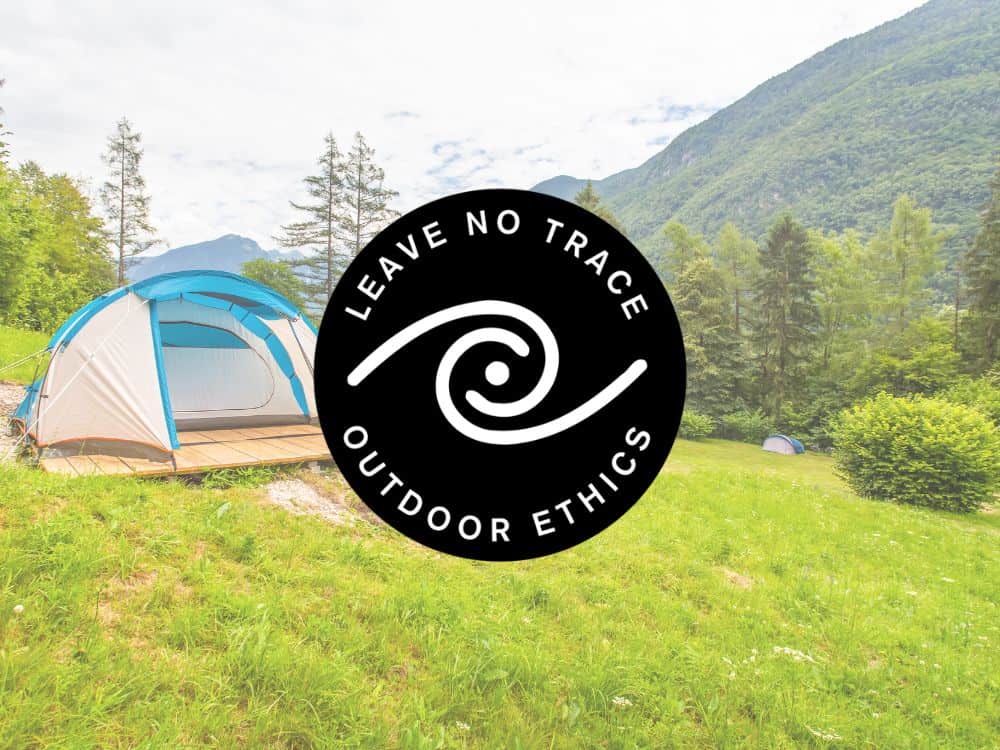
If we had to describe environmentally friendly camping with one concept, it would be Leave No Trace.
No eco camping trip is complete without these guiding principles.
The Leave No Trace Center for Outdoor Ethics is a non-profit organization committed to providing education, skills, and research to help people care for the great outdoors. It seeks to keep camping destinations and other outdoor locations pristine and in good health for everyone who follows.
Instead of expensive restoration programs or access restrictions, LNT educates the public with seven principles to help promote responsible outdoor recreation:
1. Plan ahead and prepare
Proper planning and preparation are crucial for a safe, enjoyable, and sustainable camping trip. Inadequate planning often results in unhappy campers and damage to natural and cultural resources.
- Determine and set the expectation for your trip.
- Identify the skills and capabilities of each participant.
- Learn about the area from land managers, maps, and other resources.
- Select camping sustainable gear for comfort, safety, and responsibility.
- Plan your trip to suit your goals, skills, and abilities.
- Consider the weather, terrain, and any regulations or restrictions.
Effective planning benefits the group’s safety, minimizes damage to the environment, and increases self-confidence for future trips. Doing a little bit of research and preparation goes a long way.
2. Travel and camp on durable surfaces
Eco-friendly camping is best done on durable surfaces, like established trails, campsites, and rock or gravel. The goal is to avoid travel damage, which occurs when surface vegetation and organisms are trampled beyond recovery.
Travel damage causes barren areas, soil erosion, and undesirable trails. Traveling on established routes and spreading out off the beaten path can reduce negative environmental impacts.
3. Dispose of waste properly
Packaging out all waste—including food scraps, litter, and human waste—is crucial. Sites with waste disposal facilities should be used.
Proper waste disposal helps maintain the beauty of wild spaces, reduces pollution, and minimizes the chances of attracting wildlife to campsites.
Taking responsibility for organic waste preserves the environment for future campers.
4. Leave what you find
If every camper thought, “Picking a few flowers won’t hurt,” the outdoors would soon be a barren wasteland.
Natural and cultural resources should be left as they are found. This includes not picking flowers, breaking branches, or disturbing archaeological areas.
Carving initials, peeling tree bark, and make-shift improvements (such as damming up a stream to cross it) are also a no-go.
5. Minimize campfire impacts
Campfires can significantly impact the outdoors by causing soil compaction, destruction of vegetation, and, in the worst case but all-too-common scenario, wildfires.
Using established fire pits, keeping fires small, using dead wood, and extinguishing fires completely are necessary to support the environment.
6. Respect wildlife
Sustainable camping often takes place in the homes of wildlife, meaning it is important to take measures to protect and respect these animals. Observing animals, like bears, wolves, and deer, from a safe distance, keeps everyone safe and doesn’t interfere with their natural behavior.
Storing food properly, avoiding feeding animals, and not disturbing wildlife habitats are other principles to respect the natural environment.
7. Be considerate of other visitors
Camping trips are usually a communal activity, making it important to be respectful of others’ space and privacy.
Keeping noise levels low and avoiding loud music or disruptive activities allows everyone to enjoy the sounds of nature. Staying mindful of where you set up camp ensures you don’t encroach on other camper’s space.
3. Types Of Eco-Friendly Camping

The smell of pine trees, the sounds of babbling brooks, and the earth beneath your feet…these are just some of the millions of reasons why humans seek solace in nature.
They’re also just a few reasons why it’s essential to consider the impact different camping styles have on the environment.
What are the pros and cons of each method? And which camping style is the most sustainable?
Tent Camping
Tent camping is the most basic and traditional form of camping.
While tent camping can occur in developed campgrounds, it’s often associated with backpacking or backcountry camping, where individuals hike into the outdoors, packing in all their own gear and supplies.
Some of the environmental conservation advantages of tent camping include the following:
- Minimal impact on the environment: Responsible tent camping can have a low impact on the environment. Selecting durable surfaces, packing out waste, and using dead wood for fire can reduce the adverse effects on the environment.
- Reduced resource usage: Tent camping requires fewer resources than other options. It doesn’t require electricity, running water, or other amenities that can be resource intensive. This helps reduce the overall carbon footprint when camping.
- Minimal disruption to wildlife: Using the best practices when tent camping can be less disruptive to the natural ecosystem. Staying on marked trails and using previously highly-impacted sites are a few methods to minimize your impact.
However, tent camping also has some environmental disadvantages:
- Less self-contained: Tent camping does not provide the same levels of amenities as other methods, like running water and electricity. Because it is less self-contained, you’ll need to select areas for a kitchen and bathroom, which can impact the ecosystem.
- Large groups = large impact: Larger groups can have a greater influence on the environment when tent camping. High-use areas and impromptu campsites can quickly turn into “mega sites,” which erode the environment.
- Incorrect practices can be devastating: Using incorrect tent camping techniques can quickly erode, damage, and harm the natural ecosystem when tent camping. It is crucial to use LNT principles and plan ahead to reduce your impact.
Car Or Van Camping
Van or car camping involves designated campsites accessible by vehicles. It’s a popular choice for families or large groups who don’t want to stress about packing limited gear or want access to amenities like running water or electricity.
Although you might not expect it, car camping has a few environmental advantages:
- Self-contained resource and waste management: Car camping offers easy access to amenities, like running water, electricity, and bathrooms. Many vehicles include a gray water tank and toilet, which can prevent additional waste in the ecosystem.
- Designated campsites: Car camping typically includes designated campsites. These locations have already been impacted, reducing additional harm to wildlife areas and natural sites.
- Reusable gear: A van has more storage space than a tent or backpack (not to mention none of the weight concerns). This allows you to bring more sustainable foods and reusable containers and gear.
Van and car camping have its fair share of environmental disadvantages, including the following:
- Higher overall climate impact: Van camping demands the use of resources like fuel, electricity, and water. Vehicles contribute to air pollution, greenhouse gas emissions, and can cause damage to roads and infrastructure in remote areas.
- Driving over nature: When traveling to a campsite by car, it is possible to drive over ecosystems and flora, increasing the speed of erosion or outright destroying natural habitats.
- Greater reliance on single-use items: Careless campers can use more disposable goods (like paper plates and plastic utensils) and generate more waste.
RV Or Trailer Camping
RV camping involves camping in a recreation vehicle, which serves as both transportation and shelter.
Many think of it as luxury eco camping.
Sizes can vary drastically, but RVs (which include eco camping trailers) usually include sleeping quarters, bathrooms, kitchens, and other amenities.
Eco-friendly RV camping is possible and has several advantages:
- Renewable energy options: Many RVs can be outfitted with solar panels or other renewable energy sources to power batteries and LED lights. This reduces the reliance on fossil fuels and the carbon footprint of camping.
- Reduced use of single-use products: RVs may lessen the need for single-use items, like paper plates and plastic utensils. Most models include a kitchen and can be equipped with reusable dishes and eco-friendly cutlery.
- Self-contained waste: An eco camp travel trailer typically has built-in waste management systems, like gray water tanks and black water (AKA toilet) tanks that make packing out waste easy and natural.
Just other methods, RV camping has a few environmental disadvantages to be aware of:
- Higher fuel consumption: RVs use more fuel compared to other camping vehicles or human-powered adventures. This contributes to air pollution and consumes more fossil fuels.
- Greater reliance on amenities: Many RV campers rely on resource-intensive amenities, like air conditioners, generators, and other electrical systems. This causes higher energy usage and generates waste, contributing to climate change.
- Large size and weight: Like vans, RV campers can damage roads, infrastructure, and natural environments. RVs are larger and heavier than traditional vehicles, which makes these disadvantages even more apparent.
4. Choosing An Eco Camping Site
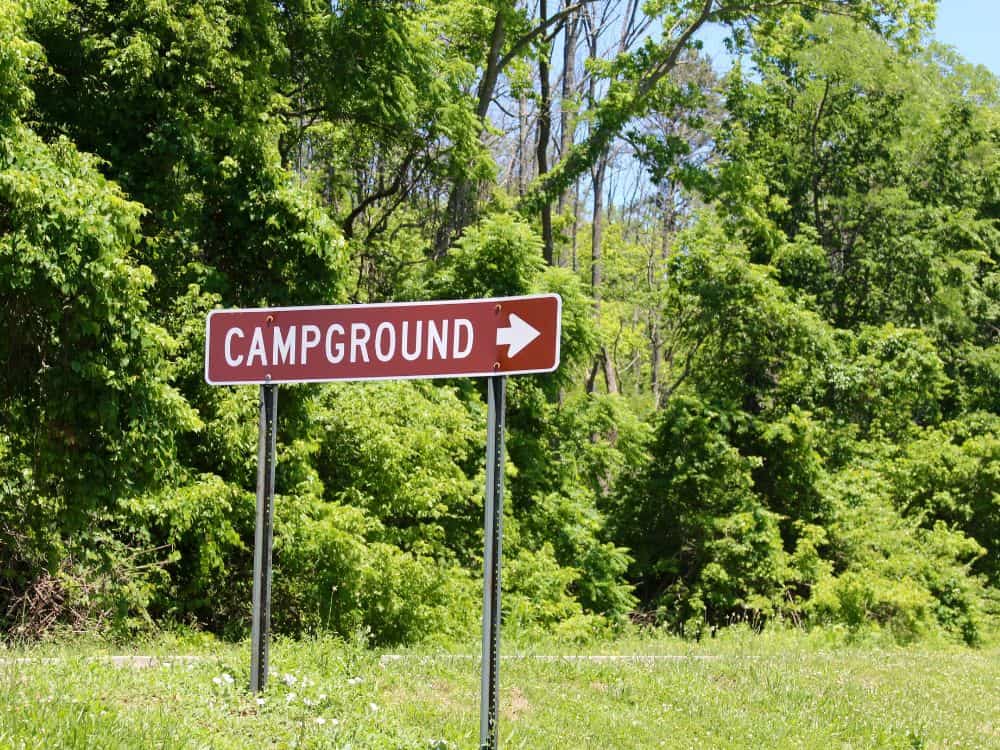
Your choice of the campsite has a significant impact on your camping experience and the environment, so you should know how and when to choose campgrounds, dispersed camping, or backcountry campsite options.
So, what is an eco camp?
No matter what eco camping sites you prefer, it’s critical to use the appropriate responsible camping techniques to minimize harm to the environment for each one.
Campgrounds
Camping can be a wild adventure, but sometimes it’s nice to have a few creature comforts of civilization. That’s where campgrounds come in. You might miss the thrill of foraging for berries or fending off bears, but hey, at least you sit on a (sort of) real toilet.
Campgrounds have several advantages to the environment, including the following:
- Access to waste disposal amenities such as toilets and trash facilities
- Protection of wildlife habitats and sensitive ecosystems
- Designated and protected fire pits
- Forest ranger oversight to ensure rules are being followed and address any issues
You might select campgrounds over other campsites, depending on your group size, weather conditions, and skill level.
Amenities like running water, toilets, and sometimes showers make campgrounds more comfortable and convenient—thus making camping more accessible to people who may not yet have all the know-how to head into the backcountry.
They can also minimize the impact on the environment, as these are designated locations without much wildlife.
That said, campgrounds have their fair share of ecological disadvantages as well:
- Crowded conditions lead to noise pollution and stress on the environment
- Potential to detract from the sense of adventure and exploration associated with wilderness camping
- Ease of access can draw types of people who don’t care to practice sustainable camping efforts
It is important to use sustainable practices, even at high-volume campgrounds. Disposing of waste correctly, respecting the ecosystem, and using designated trails are a few tips to keep in mind.
Dispersed Camping
If you prefer to “disperse” and chill, dispersed camping might be suitable for you. Sometimes called primitive camping, it involves setting up camps in undeveloped areas outside of established campsites.
If eco camping in the US, this mostly refers to National Forest or Bureau of Land Management (BLM) land.
These sites are popular among van lifers and car campers, since they don’t always require you to hike long trails to find your resting point.
It requires a bit more planning, preparation, and effort, but there are several environmental advantages:
- More immersive nature experience
- Increased self-sufficiency without the preparation demands of backcountry camping
- It’s free (and legal—for 14 days at a time, at least)!
- Dispersed impact over a wider area, reducing damage to plant life, soil, and water sources.
The freedom to explore unspoiled natural surroundings provide a more immersive experience, but at a cost:
- Risk of environmental damage if Leave No Trace principles are not followed
- Lack of amenities such as toilets and trash facilities, which can lead to littering
- Limited accessibility, requiring hiking or off-road driving to reach remote locations
- Lack of rule enforcement and accountability for rule-breaking
Without readily available amenities, dispersed camping requires more self-sufficiency, a broader skill set, planning, and supplies.
This method can also cause environmental damage if Leave No Trace principles are not followed. Campfires can damage soil and vegetation, improper waste disposal can contaminate water sources, and using the wrong surfaces can harm natural habitats.
Backcountry Camping
Backcountry camping is similar to dispersed camping but with a bit more Bear Grylls flare.
This method almost always includes hiking all of your equipment, food, and water (or at least a way to purify water) to your rest point.
Most backcountry camping trips involve setting up camp at designated sites or in areas where backcountry camping is allowed. In some areas, campers must obtain special permits in advance, again enforcing the necessity to properly plan.
Despite additional planning, preparation, and hiking, backcountry camping has several advantages:
- Encouragement of sustainable living
- Reduced energy consumption (you can haul in some portable solar panels, but otherwise, it’s the epitome of au natural!)
- Reduced impact via rarely visited sites
Like dispersed camping, backcountry trips can minimize harm to natural habitats and sensitive ecosystems. Without running water or electricity, less energy is used, and there is an emphasis on sustainable choices.
No camping method is perfect, and backcountry camping has some downsides to be aware of:
- Risk of environmental damage if Leave No Trace principles are not followed
- Disturbance of wildlife
- Damage to historical and cultural sites
Not adhering to LNT principles can cause soil erosion, water damage, and harm to the environment. Disruptions to wildlife and natural habitats are possible, especially if campers are not familiar with proper wildlife etiquette.
Damage or disturbance of historical and cultural sites is another possibility if campers are not aware of their presence.
5. Road Vs. Off-Road: Travel To Your Sustainable Campsite
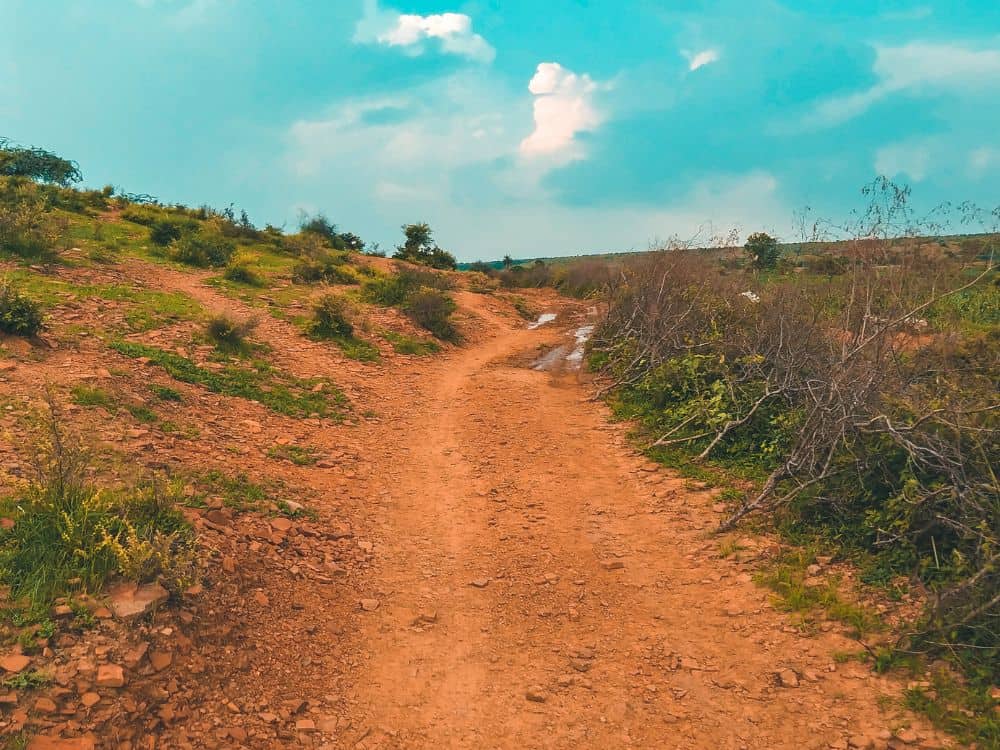
The best eco-friendly camping techniques aren’t limited to recycled materials and durable surfaces, which means it’s essential to consider the environmental impacts of how you’ll arrive at your eco camp destination.
Driving on established roads can prevent further environmental damage, reduce the risk of erosion and soil degradation, and also protect water sources from pollution.
Driving off-trail or over brush can lead to long-lasting damage that can take years to repair. It can destroy fragile ecosystems like wetlands, riparian zones, and wildlife habitats. These visible scars on the environment remain for years.
Worse, they’ll encourage others to follow in their footprints (er, tire treads), leading to negative environmental impacts that can be much longer lasting.
Minimize your impact on the environment by staying on established trails and roads at all times.
If you’re driving, try to carpool or use public transportation whenever possible. Don’t veer off the road into the bush to avoid potholes or ruts.
Some access roads may require 4×4 or high-clearance vehicles (and if so, know beforehand, so you don’t end up in a sticky spot), but if not, opt for smaller, fuel-efficient vehicles that have a lower impact and carbon footprint.
6. Choosing the Right Location: Setting Up An Eco Camp
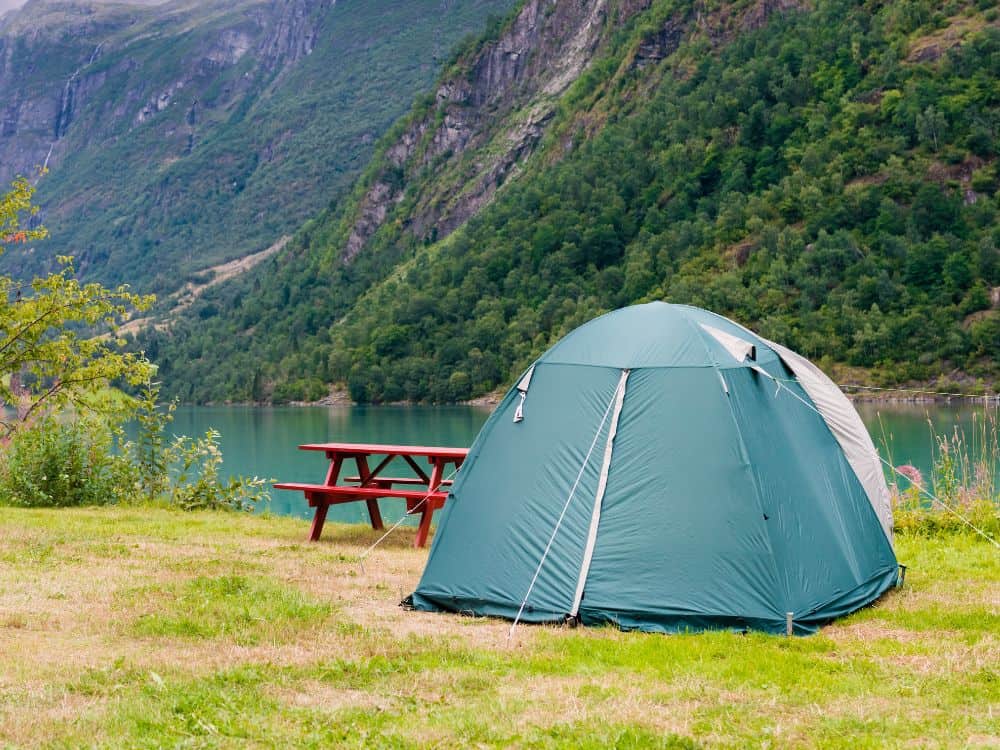
Camping can be in-tents, but it’s vital to stay calm and select the best location to minimize damage to the environment.
Regardless if you’re pitching a tent or parking an eco-friendly camper, the type of surface you choose plays a significant role in your impact on the ecosystem.
What’s under you?
It may be tempting to set up camp on lush, green vegetation, but doing so can damage the environment.
Camping on vegetation often leads to soil erosion, damages natural ecosystems, and contributes to the degradation of the environment. Instead, look for sites where vegetation is sparse or non-existent, like rocky areas and established campsites.
Sleeping on rocky surfaces may not recreate your Snow White fantasy, but it’s a small price to pay for protecting the environment. Plus, with modern inflatable sleeping pads, you’ll hardly feel the pebbles.
Avoid camping or traveling on living soil at all costs.
Living soil found in desert regions is known as a biological or cryptobiotic soil crust, or colloquially, “crypto”—no, not the Bitcoin kind.
Appearing as blackish, irregularly raised material on the sand, it’s made up of tiny communities of organisms that are a crucial protective layer to the environment, retaining moisture and preventing erosion.
A single footstep can destroy the fragile environment for years, so use established nature walks and trails, walk on rocks to avoid it, and never set up camp on top of it.
Animals can’t be expected to be self-aware of what they’re walking on, so if camping with your zero waste dog, keep them on a leash at all times.
What’s near you?
Another important factor is your proximity to water sources. Setting up camp too close to waterways can lead to soil erosion, contaminate water sources, and damage aquatic ecosystems.
Instead, camp at least 200 feet away from any water source to protect it and minimize your impact on the surrounding wildlife.
Camping too close to established trails can also cause degradation and damage to vegetation. Always camp at least 50 feet off designated trails to protect its integrity and minimize harm to the surrounding environment.
7. Building a Sustainable Campfire

Perhaps THE most critical step in making camping eco-friendly is responsible fire management.
Why?
Because carelessness with a single campfire can cause environmental destruction on a mass scale.
In 2022, over 61,000 wildfires were caused by unattended campfires, burning debris, discarded cigarettes, and other human causes.
These fires damaged over three million acres of land, destroying natural habitats, releasing pollutants into the air, eroding soil, and impacting water sources.
While wildfires are, to some degree, a natural phenomenon and an “essential part of forest and rangeland health”, climate change and careless human behavior is causing them on an unprecedented scale.
With hotter, drier environments, wildfires are easier to start than ever and more destructive once they do.
That’s why it’s crucial to employ eco camping tips to ensure things stay under control and that you, your friends, and the environment are protected.
Pay attention to fire bans and permit requirements.
Before you embark, know whether you’re even allowed to make a campfire. During especially hot, dry seasons, the forest service may enact a regional fire ban..
Other areas require you to get a campfire permit. These are usually free and easy to obtain online.
Use established fire pits.
To reduce the impact of fires on the ecosystem, always build fires in existing fire pits and fire rings. Established fire pits mitigate the effect on the surrounding environment and help prevent the spread of wildfires.
Always keep your fire contained and small, only burning when you need it.
NEVER leave a fire unattended.
Stay away from waterways.
Many campsites and backcountry wilderness areas prohibit campers from starting fires within 200 feet of waterways—with hefty fines attached if caught by a forest ranger.
Even if not explicitly prohibited, it’s best to follow this rule regardless.
Fires can contribute to water pollution by releasing harmful chemicals and ash into the water. The smoke and smell of the fire can disrupt the natural behavior of animals and may cause them to avoid the area altogether.
Take precautionary measures.
Always pack in a shovel, hatchet, and water bucket in case the fire gets out of hand—you’ll also avoid expensive fines in some backcountry sites.
Avoid starting fries under tree canopies and pick open areas to avoid accidents. Dead and downed wood is the best choice for a fire, as they do not contribute to the depletion of living trees.
Lastly, it’s essential to use water to ensure a fire is completely extinguished before going to bed or leaving the site.
Burn all the wood to white ash, ensure it is cool to the touch, and scatter the remains over a large area away from water and your campsite.
What if there isn’t a fire pit available?
What should you do if there isn’t a fire pit available, like in the backcountry?
Do not build one, even if someone has left a primitive rock ring before you.
Instead, plan ahead and bring an eco camping stove to cook food. These are essential tools for low-impact camping.
While most burn fossil fuels, they’re actually the more low impact choice, especially if choosing types that operate using refillable fuel bottles rather than single use gas canisters.
Camping stoves are fast, versatile, eliminate the need for firewood, and won’t leave any trace of use.
8. The Cat Hole Solution: Waste Disposal For Eco Camping Trips
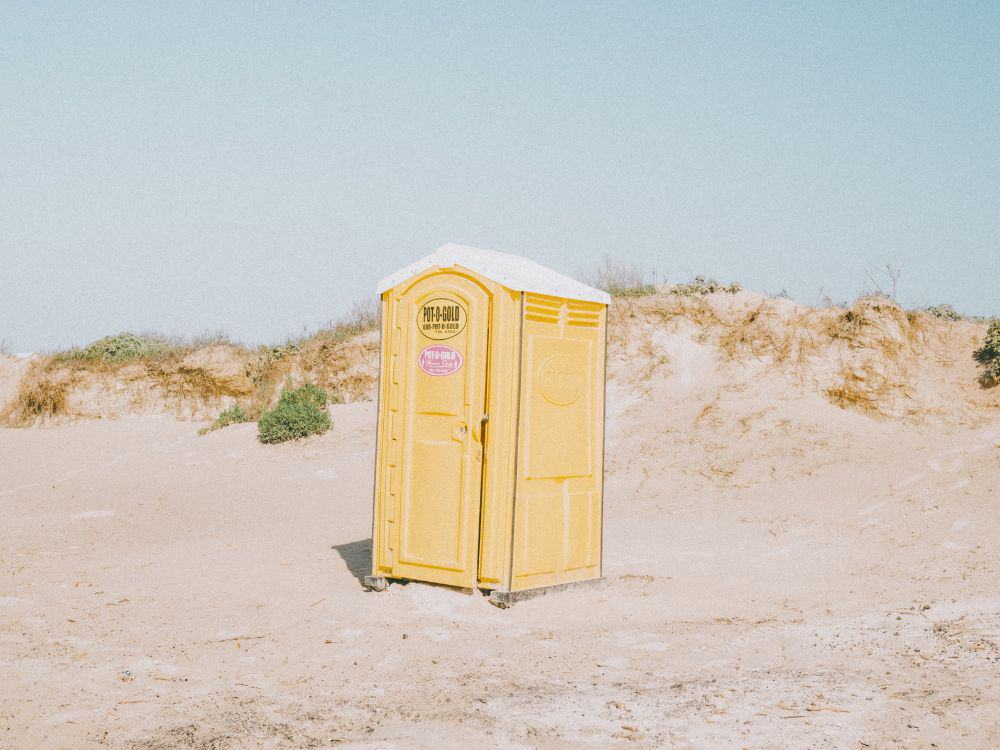
“Pack it in, pack it out.”
Sustainably disposing of waste—both disposable packaging waste and human waste—correctly is crucial to prevent polluting water sources and spreading disease.
Plus, consider how you would feel if you rolled up to your favorite campsite to find a big pile of human waste…
How to poop in an eco-friendly way
First, if there’s an outhouse or port-a-pottie, use that—yes, even if it smells awful.
But what happens if there isn’t a designated area to do your business?
Catholes are a significant area of contention for outdoor enthusiasts.
Depending on the environment, it used to be largely acceptable to dig a hole 6-8 inches deep to do your business. But with so many people now accessing the outdoors, this is no longer considered a sustainable practice.
Instead, it’s recommended to bring an eco-friendly sealable “wag bag” and pack out all waste. Bring an extra dry bag for your wag bag if you’re worried about potential leaks.
This is especially important in arid, desert climates where there isn’t enough moisture to decay human feces.
What about toilet paper?
It’s best to use toilet paper sparingly when in the great outdoors, and it should always be packed out in a wag bag.
Burning toilet paper is not advised and can potentially create wildfires, so it is best avoided.
Prioritize plain, white, non-perfumed, eco-friendly toilet paper—or better yet, bring a squirt top water bottle for a good ol’ “backcountry bidet”.
9. Staying Clean & Green With Eco-Friendly Soap For Camping

Mother Nature wants you to stay clean when traversing the backcountry.
Environmentally friendly soap for camping is a popular solution, as it breaks down quickly and has a lower impact on the environment.
That said, biodegradable soap has its downsides due to misuse and misunderstandings. Just because soap is “biodegradable” doesn’t mean it’s benign.
Using that natural hot spring or pristine pond as a bathtub might look appealing, but if biodegradable soaps are used directly in waterways, it leads to an increased the amount of phosphorous and subsequent eutrophication (nutrient over saturation that creates harmful algae growth that blocks sunlight and eventually chokes out natural life).
Instead, use a bucket or collapsible sink (they even make pocket-sized ultralight versions for backpacking) to collect water and wash in, using as little soap as possible.
When finished, dump your soapy water at least 200 feet away from streams or lakes. Either dig a hole or scatter it broadly in lush vegetation to ensure proper biodegradation.
10. Eco Camping Gear To Get You Started
Sustainable sleeping bags, eco camping stoves, eco-friendly water bottles—this is just some of the eco camping gear you’ll need for your next camping trip into the woods.
Check out our complete list of sustainable camping gear made from recycled materials to start your next camping trip on the right foot.
Here are a few ideas to get you started on the right sustainable hiking boot-clad foot:
- Portable solar panels from Goal Zero
- Sierra Designs Night Cap recycled sleeping bag
- Plastic-free water bottles from Klean Kanteen
- Kammok Mantis recycled hammock tent
- Don’t forget the sustainable snacks to stay energized!
If you’re a casual camper but don’t do it often enough to justify the high cost-entry barrier of some of the gear, you can try renting gear instead. That way, you save money and don’t necessitate the needless manufacturing of more products.
REI and some local outdoor shops often offer rental options for equipment like tents, sleeping pads, sleeping bags, and trekking poles.
11. Eco Camping Tips For After Your Trip

Practicing sustainable camping doesn’t end after you hit the highway.
There are steps you can take to ensure the campsite you left stays protected and supported for future use.
If you want to share your trip on social media, avoid geotagging the location unless it’s a large, established site. Geotagging can attract too many people into fragile ecosystems that can’t handle the load.
Continually educate your friends on the best environmentally friendly camping practices and what they can do to minimize their impact on the environment.
You can also incorporate Leave No Trace principles in your daily sustainable living efforts by being mindful of the ways in which you interact with the natural world.
Did you know we Have a Newsletter?
We cover the latest in sustainable living, fashion, zero waste, beauty, travel, finance and more…
Final Thoughts On Eco-Friendly Camping
There’s a lot to consider when seeking sustainable alternative camping methods: locations, gear made of recycled materials, preparedness, resources, fire pits, waste disposal, lions, tigers, and bears (oh my!).
But the proper techniques come easily and protect the environment from unnecessary damage, keeping it intact for future generations.
Properly planning, practicing Leave No Trace principles, packing out what you bring in, and being mindful of your surroundings help keep you and the environment safe for many sustainable camping adventures to come.
Do you have a friend who loves the great outdoors? Ever heard them asking, “How can I be eco-friendly when camping?”
Send them this guide to eco camping to help them be an earth-happy hiker during their next outdoor outing.
Pin these:
